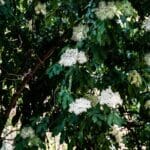Elaeagnus x ebbingei is a hardy, fast-growing shrub with a delightful scent when in flower and edible fruits. This plant’s adaptability and tolerance for a variety of growing conditions make it an ideal choice for your garden.
Facts about Elaeagnus Plant
There are about 50 to 70 different species of Elaeagnus native plants occurring naturally from Australia through Asia and in North America. They vary in shape and size and may occur as shrubs or small trees that may be deciduous or evergreen.
Ebbings Silverberry, also commonly known as oleaster, is a hybrid between Elaeagnus macrophylla and Elaeagnus pungens, both of which are native to eastern Asia. This large broadleaf evergreen shrub can reach a height and width of 16ft (5m) and makes an excellent garden shrub.
The thorny branches of this shrub lack spines and its leaves are discolorous, which means they differ in color on either surface. In the case of Elaeagnus x ebbingei, the undersides of the leaves are silvery while the top surfaces are green. Variegated leaf varieties are also available.
Leaves are alternating, simple, oblong-elliptic, 5-10 cm long, with whole and undulate edges, tip sharp, base wedge-shaped, glossy dark green above, dull silvery below, with clear or brown scales (spots).
While generally an evergreen shrub, this deer-resistant plant will be deciduous when grown in areas on the colder end of its limits.
It has the potential to form dense thickets, displacing native species and upsetting animals.

What Is A Hybrid?
Hybrid plants are common in the gardening and horticultural trade. But what exactly is a hybrid? A hybrid is a cross between two different species of plants, generally to combine attractive or useful characteristics both.
The ‘x’ in the name of this plant gives away its hybrid status. The seeds produced by hybrid plants, if fertile, generally will not produce plants that look or grow like the parent plant.
Elaeagnus Flowers
Elaeagnus blooms in the fall, from October to November, producing a profusion of wonderful smelling cream-white flowers. While these silvery white flowers, which lack petals, may not be particularly conspicuous and attractive, their fragrance certainly contributes greatly to the atmosphere of a garden.
Attractive red fruits with silver markings are produced after flowering. These fruits, measuring less than an inch in length, and half that in width (2cm x 1cm) are not only edible but very tasty too if harvested at the right time.
Unripe fruits of this bee-pollinated plant tend to have a sour, astringent flavor. The seeds of Elaeagnus x ebbingei are also edible and a good source of vitamins.
How To Grow An Elaeagnus Bush
While Elaeagnus shrubs may be grown from seed, Elaeagnus x ebbingei seed will not produce plants that are true to type, and therefore growing from cuttings is recommended if you desire new plants.
Fortunately, E. x ebbingei is easily grown, if rather slowly, from cuttings taken in summer and of around 3-4 inches(7.5-10cm) in length. Cuttings should be treated with a growth hormone powder for best results.
Ebbing’s silverberry can be quite slow-growing in its first year but becomes vigorous and fast-growing once established. Elaeagnus is a very tough and adaptable plant that can be pruned heavily.
This plant tolerates a wide variety of soil types, from sand to loam to clay, although it prefers a well-drained substrate. This plant also prefers soil that is not overly nutrient-rich and, interestingly, has the ability to improve the soil in the vicinity of its roots through the process of nitrogen-fixing.
Elaeagnus hedge can be grown in a range of soil pH levels from acid to alkaline.
This plant has only moderate watering requirements and is quite drought resistant once established. Elaeagnus shrub can be grown in full sun to deep shade and is tolerant of strong winds and salt spray, making it an ideal plant for coastal gardens.
This plant can be grown in USDA Hardiness Zones 7 to 9 and to UK zone H6.
What Is A Nitrogen Fixer?
Nitrogen-fixing plants have special bacteria, known as Rhizobium, that grow on their root surfaces. These bacteria are able to capture atmospheric nitrogen and store it in a nodule on the root surfaces.
Very little of this nitrogen is available to other plants while the nitrogen-fixing plant is alive, but once dead, a decomposing plant will release its stored nitrogen into the soil to the benefit of other plants in the vicinity.
Care And Maintenance
Elaeagnus x ebbingei is a tough, low maintenance plant that requires very little in the way of care and maintenance from the gardener.
Cultivars
‘Coastal gold’ is a variegated variety with broad, mostly yellow leaves with narrow green margins.
‘Gilt edge’ is a variegated variety with golden yellow margins to its dark green leaves.
‘Limelight’ is a variegated variety that has silvery young leaves, maturing to varying shades of golden yellow, lime green and dark green.
Uses
Elaeagnus x ebbingei is often grown as a hedge for privacy and tolerates heavy pruning, allowing for a tight and narrow hedge. One of this plant’s most useful characteristics is its tolerance for strong winds and salt spray, making it an excellent windbreak plant for coastal gardens and other windy areas where other plants may not survive or thrive.
As mentioned, the high food value of this plant makes it a great addition to an edible garden. Fruit-eating birds such as waxwings will appreciate whatever fruit you miss.
FAQs
Is Elaeagnus cold hardy?
Many Elaeagnus varieties are cold-hardy and can withstand a range of temperatures, making them suitable for various climates.
Is Elaeagnus a good hedge?
Elaeagnus can make a good hedge due to its dense foliage, tolerance of pruning, and ability to provide a barrier.
In conclusion, Elaeagnus x ebbingei is a very useful and attractive shrub which is adaptable to a variety of growing conditions. In coastal and windy areas this plant’s toughness will really shine through. The fragrant flowers and edible fruits are just the cherry on top.






